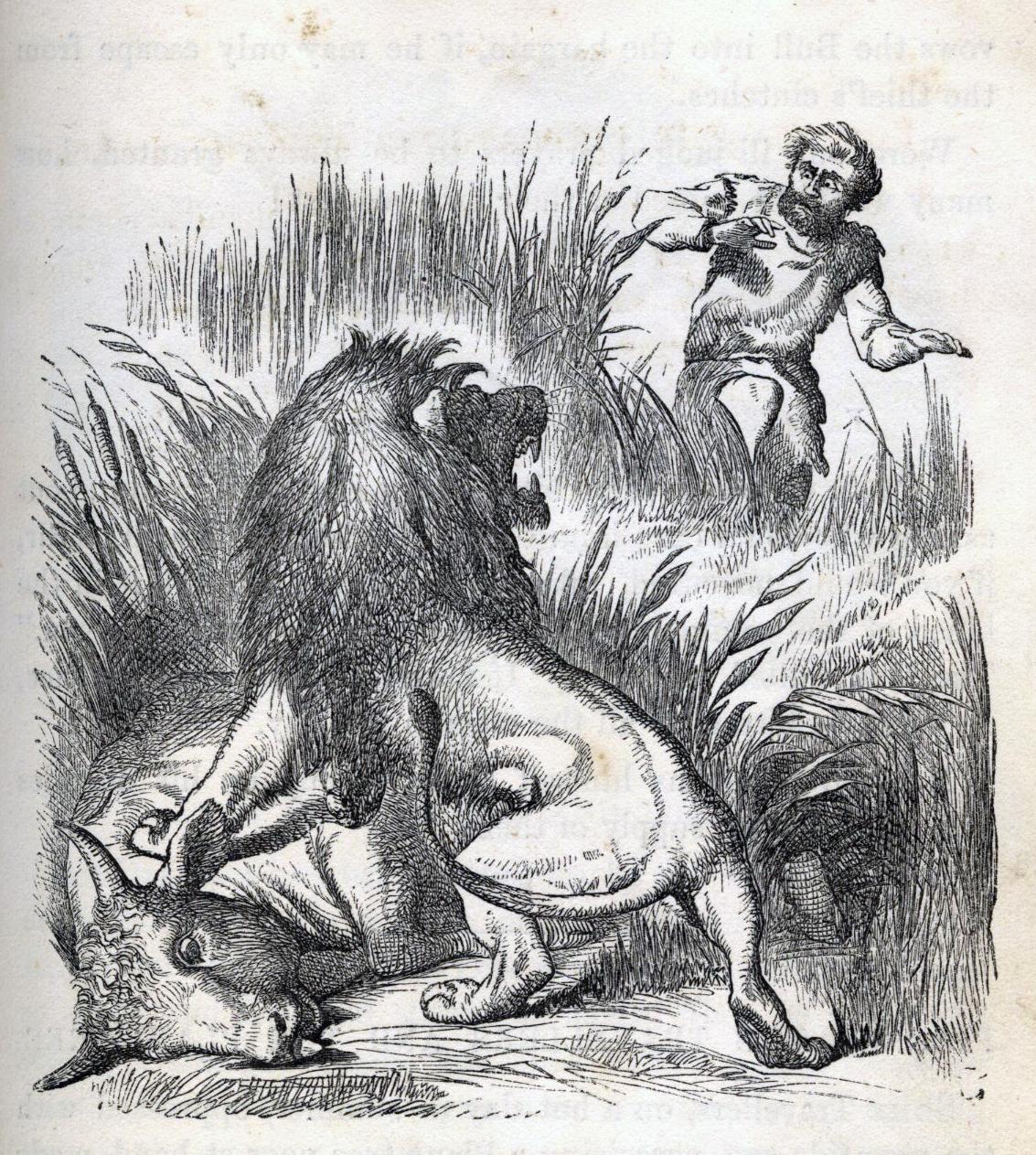Britain is famous for its diverse iconography, incorporating an immense array of animals into its symbolism. The British Lion is unparalleled in its recognizability and importance to Britain’s history and identity. The image of the lion has become synonymous with Britain itself, especially in the Victorian Age. During this time period, the British Lion made appearances in nearly every artistic form available.
John Tenniel, "The Herdsman and the Lost Bull," from Aesop's Fables, adapted by Rev. Thomas James, 1848. John Tenniel immortalized the British Lion in his illustrations and elevated the symbol in the Victorian Era, but he also excelled in drawing the magnificent animal. In “The Herdsman and the Lost Bull,” a herdsman has lost a calf and prays to G-d to find the lost animal. He discovers the calf being eaten by a lion and vows he would also sacrifice a full-grown bull if he could escape the encounter alive. Tenniel illustrates the British Lion as an intimidating figure; as Catherine Golden notes in "John Tenniel's Animals," “the lion exudes invincibility from its razor-sharp teeth to its claws ” (25-26). Tenniel features the animal's powerful stance, silhouetted face, and rows of sharp teeth as well as the herdsman's fear.
John Tenniel, "The British Lion's Vengeance on the Bengal Tiger," Punch, 1857. In this second image, Tenniel presents the British icon in a now famous Punch cartoon to show the threat, power, and authority of Britain. Tenniel created this illustration, “The British Lion's Vengeance on the Bengal Tiger,” in the wake of the 1857 Indian Mutiny when Indian troops sparked a rebellion against the British East India Company’s rule over the country. The illustration depicts a ferocious looking lion pouncing on a Bengal tiger that is pinning down its prey: a woman carrying a child. The lion represents the British revenge on Indian native troops “who had committed atrocities against British women and children” (Victorianweb.org). The British Lion is conveying a lust for vengeance; the power communicated in the animal's lunge connotes the explosive reaction to the mutiny. However, the lion here also serves as a protector figure to comfort the British who feared the mutiny. Overall, however, Tenniel’s cartoon acts as propaganda to warn India of imminent British victory (Matei).
John Tenniel, "The Lion and the Unicorn," from Alice Through the Looking-Glass, by Lewis Carroll, 1872: The Lion appears on the Royal Coat of Arms of Britain and Scotland alongside a Unicorn, symbolizing the two countries respectively. Tenniel revisits the symbol in his illustrations for Through the Looking-Glass by Lewis Carroll. The third image in this case depicts a Lion and a Unicorn fighting for the right to wear the White Crown. In addition, the Lion here resembles Benjamin Disraeli while the Unicorn looks like William Gladstone, both Parliamentary figures from the Victorian age. Tenniel reflects the contemporary conflict in Parliament between Prime Ministers Disraeli and Gladstone as they vied for positions of power (Gray). Carroll and Tenniel utilize the recognizable symbolism of the lion to satirize and mock contemporary political figures and events.
Thomas Brock, Victoria Memorial Statues, 1901: The iconic visage of thelLion existed in artwork beyond the realm of illustration. The Queen Victoria Memorial, built in the wake of Queen Victoria’s death and the end of the Victorian Age, features four groups of bronze statues. At the north and south sides of the memorial stand statues “representing Naval and Military power (south) and Science and Art (north). Furthermore, at each corner of the memorial, the statues present human figures: Peace, Progress, Agriculture, and Manufacture” (Speel). The human figures are accompanied by lions. In light of how previous incarnations of the British beast convey a protecting, powerful figure, these lion statues imply that, without the lion’s watchful eye, the peace, progress, agricultural, and manufacture of Britain, and arguably all of Humanity, would not be able to advance. Simultaneously, the lions retain the fierce authority present in many of its illustrated counterparts.





